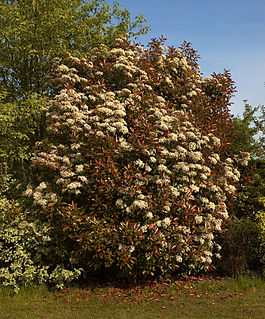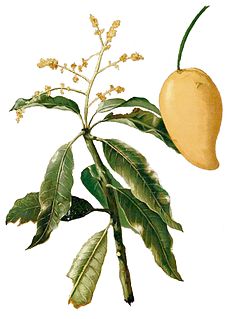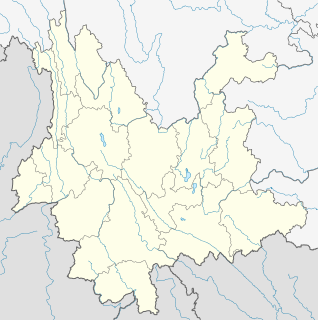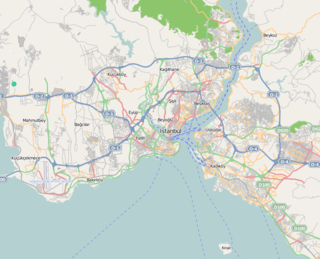
Photinia is a genus of about 40–60 species of small trees and large shrubs, but the taxonomy has recently varied greatly, with the genera Heteromeles, Stranvaesia and Aronia sometimes included in Photinia.

The Chinese pond heron is an East Asian freshwater bird of the heron family, (Ardeidae).

The conservation status of a group of organisms indicates whether the group still exists and how likely the group is to become extinct in the near future. Many factors are taken into account when assessing conservation status: not simply the number of individuals remaining, but the overall increase or decrease in the population over time, breeding success rates, and known threats. Various systems of conservation status exist and are in use at international, multi-country, national and local levels as well as for consumer use.

Hugh's hedgehog, also sometimes referred to as the central Chinese hedgehog, is native to central China and Manchuria. It prefers open areas of dry steppe, but can be found in shrubland and forests. It is known to look for food even in daytime on rainy days.

Red-cheeked squirrels form a taxon under the subfamily Callosciurinae. The six species which are all found only in Asia are listed as "Least Concern" by the IUCN.

Functional extinction is the extinction of a species or other taxon such that:
- It disappears from the fossil record, or historic reports of its existence cease;
- The reduced population no longer plays a significant role in ecosystem function; or
- The population is no longer viable. There are no individuals able to reproduce, or the small population of breeding individuals will not be able to sustain itself due to inbreeding depression and genetic drift, which leads to a loss of fitness.

A species that is extinct in the wild (EW) is one that has been categorized by the International Union for Conservation of Nature as known only by living members kept in captivity or as a naturalized population outside its historic range due to massive habitat loss.
Nouelia insignis is a species of flowering plant in the family Asteraceae, and the only species in the genus Nouelia. It is found only in Yunnan and Sichuan provinces, China, where it is threatened by habitat loss.

Helicia is a genus of 110 species of trees and shrubs, constituting part of the plant family Proteaceae. They grow naturally in rainforests throughout tropical South and Southeast Asia, including India, Sri Lanka, Indochina, Peninsular Malaysia to New Guinea and as far south as New South Wales.
Helicia albiflora is a species of plant in the family Proteaceae. It is endemic to Papua New Guinea. It is threatened by habitat loss.
Helicia amplifolia is a species of plant in the family Proteaceae. It is endemic to Papua New Guinea. It is threatened by habitat loss.
Helicia neglecta is a species of plant in the family Proteaceae. It is endemic to Papua New Guinea. It is threatened by habitat loss.
Helicia peltata is a species of plant in the family Proteaceae. It is endemic to Papua New Guinea. It is threatened by habitat loss.
Helicia subcordata is a species of plant in the family Proteaceae. It is endemic to Papua New Guinea. It is threatened by habitat loss.
Heliciopsis lanceolata is a species of plant in the family Proteaceae. It is found in Indonesia and Malaysia. It is threatened by habitat loss.
Heliciopsis rufidula is a species of plant in the family Proteaceae. It is a tree found in Peninsular Malaysia and Borneo. It is threatened by habitat loss.

Mangifera sylvatica, also known as the Himalayan mango, pickling mango, or Nepal mango, is a species of plant in the family Anacardiaceae. It is found in Bangladesh, Cambodia, China (Yunnan), India, Myanmar, Nepal, Bhutan and Thailand. It is a tree 6–20 m (20–66 ft) tall. The fruit measure 6 cm–8 cm × 4 cm–5 cm.
Photinia lasiopetala is a species of flowering plant in the family Rosaceae. It is endemic to Taiwan. It is threatened by habitat loss.

Fuxian Lake stretches out through Chengjiang, Jiangchuan and Huaning Counties in Yunnan Province, spanning an area of 212 square kilometers. The lake is ranked third-largest in Yunnan, after Dian Lake and Erhai Lake. Also the deepest lake in Yunnan, it is 155 meters deep at its greatest depth. It is also the third-deepest fresh water lake in China, after Tianchi and Kanas Lake.

Türkmenbaşı Nature Park is a nature park located in Sarıyer district of Istanbul Province, Turkey.









